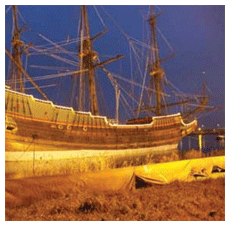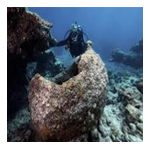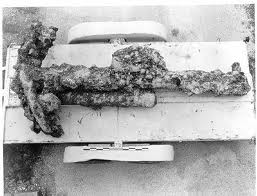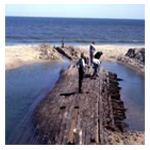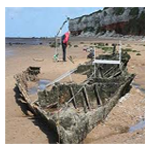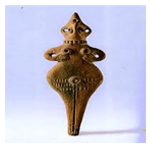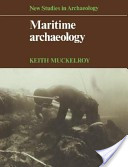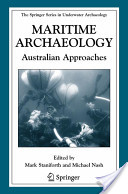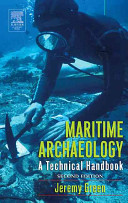- Latest Archaeology Updates
- Importance and applicability
- Famous Archaeologists
- Museums Collections
- Site Map
- World Heritage Sites
- World History Monuments
- Archaeological Organizations
- World Atlas of Archaeology
- Forensic Investigation and Geophysics
- Contact Us
- Movies based on Archaeology
- Frequently Asked Questions
- Archaeological discoveries
- Tell a Friend
- Archaeological Abbreviations
- Gallery Collections
- Famous-Museums site map
- Famous-archaeologists site map
- Archaeological Monuments site map
Maritime archaeology is a discipline that studies human interaction with the sea, lakes and rivers through the study of vessels, shore side facilities, cargoes and human remains. One speciality is underwater archaeology , which studies the past through any submerged remains. Another specialty within maritime archaeology is nautical archaeology, which studies vessel construction and use.
Maritime archaeology can be divided in a three-tier hierarchy, of which the first tier consists of the archaeology of shipwrecks and wreck sites. In this discipline the wrecking process itself is studied: how does a ship break up, how does a ship float to the bottom, and how do the remains of both ship and cargo decay over time?The second tier studies the ship as a machine, both in itself and in a military or economic system.The third tier consists of the archaeology of maritime cultures, in which nautical technology, naval warfare, trade and shipboard societies are studied.
Maritime archaeology has two important advantages over land archaeology. First the remains of ships and cargoes, even organic materials, are sometimes better preserved under water or in bottom sediments. The second advantage lies in the fact that until recently, shipwrecks were usually beyond the reach of human intervention or salvage, thereby creating perfect time capsules.
Prior to the industrial era, travel by water was regularly easier than over land. As a result, marine channels, crossable rivers and sea crossings shaped the trade routes of historic and prehistoric civilizations. For example, the Mediterranean Sea was known to the Romans as the inside sea because the Roman Empire spread around its coasts.
The famous record as well as the remains of harbours, ships and cargoes, testifies to the volume of trade that crossed it. Afterward, nations with a strong maritime culture such as the United Kingdom, Holland, Denmark, Portugal and Spain were able to establish colonies on other continents. Wars were fought at sea over the control of important resources.
The material cultural remainder that are discovered by maritime archaeologists along former trade routes can be combine with historic documents and material cultural remains found on land to understand the economic, social and political environment of the past. Of late maritime archaeologists have been examining the submerged cultural remains of China, India, Korea and other Asian nations.
There are important differences in the continued existence of archaeological material depending on whether a site is wet or dry, on the nature of the chemical atmosphere, on the occurrence of biological organisms and on the dynamic forces present.
Saltwater is particularly unfavorable to iron artifacts including metal shipwrecks, and sea organisms will readily consume organic material such as wooden shipwrecks. On the other hand, out of all the thousands of potential archaeological sites destroyed or grossly eroded by such natural processes, occasionally sites survive with exceptional preservation of a related collection of artifacts.
- Pre-historic landscapes
- Historic sites
Maritime archaeology studies prehistorical objects and sites that are, because of changes in climate and geology, now underwater.Bodies of water, fresh and saline, have been important sources of food for people for as long as we have existed. It should be no surprise that ancient villages were located at the water's edge. Since the last ice age sea level has risen as much as 400 feet (~120 meters).Therefore, a great deal of the record of human activity throughout the Ice Age is now to be found under water.
Throughout history, seismic events have at times caused submergence of human settlements. The remains of such catastrophes exist all over the world, and sites such as Alexandria and Port Royal now form important archaeological sites. As with shipwrecks, archaeological research can follow multiple themes, including evidence of the final catastrophe, the structures and landscape prior to the catastrophe and the culture and economy of which it formed a part.
Not all maritime sites are underwater. There are many structures at the margin of land and water that provide evidence of the human societies of the past. Some are deliberately created for access - such as bridges and walkways.Archaeological sites can also be found on the foreshore today that would have been on dry land when they were constructed. An example of such a site is Seahenge, a Bronze Age timber circle.
The archaeology of shipwrecks can be divided in a three-tier hierarchy, of which the first tier considers the wrecking process itself: how does a ship break up, how does a ship sink to the bottom, and how do the remains of the ship, cargo and the surrounding environment evolve over time? The second tier studies the ship as a machine, both in itself and in a military or economic system. The third tier consists of the archaeology of maritime cultures, in which nautical technology, naval warfare, trade and shipboard societies are studied.
- Bronze Age
The earliest boats discovered date from the Bronze Age and are constructed of hollowed out logs or sewn planks. Vessels have been discovered where they have been preserved in sediments underwater or in waterlogged land sites, such as the discovery of a canoe near St Botolphs. Examples of sewn-plank boats include those found at North Ferriby and the Dover Bronze Age Boat which is now displayed at Dover Museum. These may be an evolution from boats made of sewn hides, but it is highly unlikely that hide boats could have survived.
Ships wrecked in the sea have probably not survived, although remains of cargo (particularly bronze material) have been discovered, such as those at the Salcombe B site. A close collection of artefacts on the sea bed may imply that artefacts were from a ship, even if there are no remains of the actual vessel.
Late Bronze Age ships, such as the Uluburun Shipwreck have been discovered in the Mediterranean, constructed of edge joined planks. This shipbuilding technology continued through the classical period.
Underwater Archaeology is that branch of the regulation and science of Archaeology that is practiced under water, either by archaeologists outfitted with breathing equipment or by the remote control of machines. Strictly, this means archaeology under water, which is the main discipline of maritime archaeology.
Underwater archaeology is considered as a branch of maritime archaeology (the archaeology of aquatic vessels and associated infrastructure), though not exclusively: underwater excavation techniques and methodology can also be applied in the study of sunken settlement and committal sites, for instance. underwater or maritime archaeology does not essentially deal with wrecks, even if that is the part scuba divers more often deal with.
A prime example of the latter is the ongoing investigation of the remains of Ptolemaic Alexandria in Egypt by Franck Goddio, amongst others.
Maritime archaeologists have investigated several ancient cultures in the Mediterranean area.. The group of people who worked in the U.S. Navy under th deep submergence research submarine NR-1, discovered the sites in 1997. In 1999 a team lead by Robert Ballard and archaeology Professor of Harvard University, Lawrence stager investigated the wrecks. Large research has been carried out on the Mediterranean and Aegean coastlines of Turkey. Complete excavations have been carry out on several wrecks from the classical, Hellenistic,Byzantine, and Ottoman periods. Mediterranean holds countless archaeological sites elsewhere in the sea floor. In Israel, Herod the great's port at Caesarea Maritima has been largely studied. Other finds are acting with some passages of the Bible .
AustraliaIn 1970s ,maritime archaeology in Australia begins with the advent of Jeremy Green about the academics and politicians with the rampant destruction of the Dutch and British East India ships lost on the west coast.,. The specialised study of boat and ship construction is practised in the region is called Nautical Archaeology. As in the rest of the world Often the sites or relics studied in Australia are not inundated. A sub-discipline of aviation archaeology is better known as the study of historic submerged aircraft, underwater aviation archaeology is also practised in the region maritime and underwater archaeology is practised out of Museums in some states and of cultural heritage management units and all practitioners operate under the aegis of the Australasian Institute for Maritime Archaeology (AIMA)
.
Maritime archaeology - Keith Muckelroy,Cambridge University Press, 1978
Archaeology has made enormous advances recently, both in volume of discoveries and in its character as an intellectual discipline; new techniques have helped to further the range and rigour of enquiry, and encouraged interdisciplinary communication. The aim of this series is to make available to a wider audience the results of these developments. The coverage will be world-wide and will extend from the earliest period to medieval and industrial archaeology.
Maritime Archaeology:Australian Approaches - Mark Staniforth, Michael Nash,Springer, 2008
Maritime archaeology and underwater cultural heritage management have become well established over the past twenty years or so in the Asia-Pacific region, particularly in Australia. During that period Australian researchers and underwater cultural heritage managers have conducted a significant number of important maritime archaeological investigations and have developed innovative approaches to the discipline.Subject areas discussed in this book include shipwrecks and abandoned vessels,...
Maritime Archaeology:a technical handbook -Jeremy N. Green,Elsevier/Academic Press, 2004.
Jeremy Green's systematic overview of maritime archaeology offers a step-by-step description of this fast-growing field. With new information about the use of computers and Global Positioning Systems, the second edition of this handbook shows how to extract as much information as possible from a site, how to record and document the data, and how to act ethically and responsibly wth the artifacts. Treating underwater archaeology as a discipline, the book demonstrates how archaeologists,....
Maitime Archaeology in Wiki
Maritime archaeology is a discipline within archaeology as a whole that specifically studies human interaction with the sea, lakes and rivers through the study of associated physical remains, be they vessels, shore side facilities, port-related structures, cargoes, human remains and submerged landscapes.- Maritime Archaeology Programme :University of Southern Denmark Maritime Archaeology Programme
Maritime Archaeology Ltd :Maritime Archaeology Ltd specialises in services related to marine cultural heritage.Formed in 2004, Maritime Archaeology Ltd is the trading arm of the Hampshire & Wight Trust for Maritime Archaeology.
-
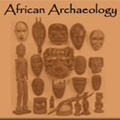 African Archaeology Africa has the longest record of human activity of any part of the world and along with its geographical extent; it contains an enormous archaeological resource. Scholars have studied Egyptology for centuries but archaeologists have only paid serious attention to the rest of the continent in more recent times.
African Archaeology Africa has the longest record of human activity of any part of the world and along with its geographical extent; it contains an enormous archaeological resource. Scholars have studied Egyptology for centuries but archaeologists have only paid serious attention to the rest of the continent in more recent times. -
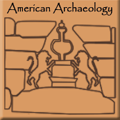 American Archaeology Archaeology of the Americas is the learning of the archaeology of North America, Central America (or Mesoamerica), South America and the Caribbean, which is to say, the pre-history and Pre-Columbian history of Native American peoples.
American Archaeology Archaeology of the Americas is the learning of the archaeology of North America, Central America (or Mesoamerica), South America and the Caribbean, which is to say, the pre-history and Pre-Columbian history of Native American peoples. -
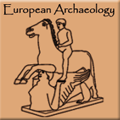 European Archaeology In terms of area, Europe is the world's second smallest continent, with an area of 10,400,000 kmē (4,000,000 square miles), making it slightly larger than Australia.
European Archaeology In terms of area, Europe is the world's second smallest continent, with an area of 10,400,000 kmē (4,000,000 square miles), making it slightly larger than Australia. -
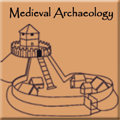 Medival archaeology The period covers the commotion caused by the fall of the Medival archaeology Roman Empire and cultures such as the Vikings, Saxons and Franks.
Medival archaeology The period covers the commotion caused by the fall of the Medival archaeology Roman Empire and cultures such as the Vikings, Saxons and Franks. -
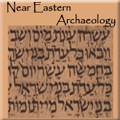 Near Eastern Archaeology Near Eastern Archaeology is a wide generalised application, and is divided into further regional sub-branches, the archaeology of modern states in the region or along broad thematic lines.
Near Eastern Archaeology Near Eastern Archaeology is a wide generalised application, and is divided into further regional sub-branches, the archaeology of modern states in the region or along broad thematic lines. -
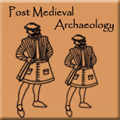 Post Medieval Archaeology The Post Medieval Archaeology is considered as a bi-annual journal study of the material evidence of European society. This period saw the conversion of medieval to industrial society.
Post Medieval Archaeology The Post Medieval Archaeology is considered as a bi-annual journal study of the material evidence of European society. This period saw the conversion of medieval to industrial society. -
 Modern Archaeology In contrast to the antiquarianism of classical archaeology, anthropological archaeology today is concerned with culture history (i.e., the chronology of events and cultural traditions) and the explanation of cultural processes.
Modern Archaeology In contrast to the antiquarianism of classical archaeology, anthropological archaeology today is concerned with culture history (i.e., the chronology of events and cultural traditions) and the explanation of cultural processes.

